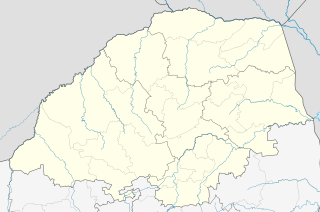Limpopo WMA, or Limpopo Water Management Area(coded: 1), [1] in South Africa includes the following major rivers: the Limpopo River, Matlabas River, Mokolo River, Lephalala River, Mogalakwena River, Sand River and Nzhelele River and covers the following dams.

South Africa, officially the Republic of South Africa (RSA), is the southernmost country in Africa. It is bounded to the south by 2,798 kilometres (1,739 mi) of coastline of Southern Africa stretching along the South Atlantic and Indian Oceans; to the north by the neighbouring countries of Namibia, Botswana, and Zimbabwe; and to the east and northeast by Mozambique and Eswatini (Swaziland); and it surrounds the enclaved country of Lesotho. South Africa is the largest country in Southern Africa and the 25th-largest country in the world by land area and, with over 57 million people, is the world's 24th-most populous nation. It is the southernmost country on the mainland of the Old World or the Eastern Hemisphere. About 80 percent of South Africans are of Bantu ancestry, divided among a variety of ethnic groups speaking different African languages, nine of which have official status. The remaining population consists of Africa's largest communities of European, Asian (Indian), and multiracial (Coloured) ancestry.

The Limpopo River rises in South Africa, and flows generally eastwards through Mozambique to the Indian Ocean. The term Limpopo is derived from Rivombo (Livombo/Lebombo), a group of Tsonga settlers led by Hosi Rivombo who settled in the mountainous vicinity and named the area after their leader. The river is approximately 1,750 kilometres (1,087 mi) long, with a drainage basin 415,000 square kilometres (160,200 sq mi) in size. The mean discharge measured over a year is 170 m3/s at its mouth. The Limpopo is the second largest river in Africa that drains to the Indian Ocean, after the Zambezi River.

The Matlabas River is a river in Limpopo Province, South Africa. It is a tributary of the Limpopo River. The river's catchment area comprises 3,448 square kilometers. The entire catchment area of the river is located within the Waterberg District Municipality.
Contents
- Cross Dam, Nwanedi River
- Doorndraai Dam Sterk River
- Glen Alpine Dam Mogalakwena River
- Luphephe Dam, Luphephe River
- Mokolo Dam Mokolo River
- Mutshedzi Dam Mutshedzi River
- Nwanedi Dam, in the Nwanedi River
- Nzhelele Dam Nzhelele River

The Nwanedi River is a watercourse in Limpopo Province, South Africa. It is a tributary of the Limpopo River flowing east of the Nzhelele, joining the right bank of the Limpopo 58 km east of Musina at the South Africa/Zimbabwe border.
Doorndraai Dam is a buttress type dam on the Sterk River, Mogalakwena River basin, located near Mokopane, Limpopo, South Africa. It was established in 1952 and has been renovated in 1974. Its primary purpose is for municipal and industrial use. The hazard potential is ranked to be high.
Glen Alpine Dam is a combined gravity and earth-fill type dam located on the Mogalakwena River, near Ga-Mankgodi, Bochum Limpopo, South Africa. It was established in 1968 and its main purpose is for irrigation use. The hazard potential of the dam has been ranked as high (3).






